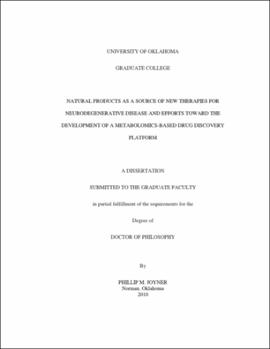| dc.contributor.advisor | Cichewicz, Robert | |
| dc.creator | Joyner, Phillip Matthew | |
| dc.date.accessioned | 2019-04-27T21:36:52Z | |
| dc.date.available | 2019-04-27T21:36:52Z | |
| dc.date.issued | 2010 | |
| dc.identifier | 99344037802042 | |
| dc.identifier.uri | https://hdl.handle.net/11244/319153 | |
| dc.description.abstract | Natural products have traditionally played an important role in drug discovery research. They have been particularly important in the search for therapies for neurodegenerative diseases. Although there are numerous forms of neurodegenerative diseases, the disorders associated with protein misfolding (e.g. Alzheimer's, Parkinson's, Huntington's and prion diseases) represent a unique area for natural products drug discovery as these diseases share many pathological features, suggesting that therapies developed for any one of these diseases may have applications for the others. There have been many reports of secondary metabolites with biological activities related to neurodegeneration associated with protein misfolding, and emerging drug targets for these diseases are fueling interest in finding natural products which can serve as leads for therapeutic development. The literature surrounding the topic of natural products and neurodegenerative disease has been summarized in the first chapter of this dissertation. | |
| dc.description.abstract | Although there have already been many natural products identified as potential therapeutic leads for neurodegenerative diseases, there is still a significant need for the enhancement of methodologies used for bioassay screening of secondary metabolites. Metabolomic approaches to drug discovery have the potential to combine the advantages of phenotypic disease models and molecular target assays. The metabolomic examination of a phenotypic disease model can provide detailed information concerning the molecular target and/or the mechanism of action of a compound while simultaneously revealing its phenotypic effects. The third chapter of this dissertation describes the metabolomic examination of a phenotypic model of Huntington's disease. This detailed exploration of the metabolic changes associated with mutant huntingtin toxicity has revealed many intriguing new insights into the specific processes which are involved in the cellular response to protein aggregation. The results in this chapter show that the metabolic response of cells to mutant huntingtin can be detected using a metabolomic approach and that these metabolic changes can be used to identify potential therapeutic targets for Huntington's disease. These results also show the importance of the metabolites alanine, glutamine, glycerol and valine in the metabolic response to mutant huntingtin in multiple species. This work provides the foundation for the future development of a metabolomic-based drug discovery platform for natural products. | |
| dc.description.abstract | In the fourth chapter of this dissertation, the use of metabolic profiling to examine the protective role of the metabolite trehalose is described. Trehalose is a disaccharide that has been previously identified as having therapeutic implications for neurodegenerative diseases. In order to explore the role that trehalose plays in the yeast model of Huntington's disease, a series of yeast strains with gene deletions for each step in the metabolic cycle of trehalose were engineered to express normal and mutant huntingtin protein fragments. One of these gene deletion strains, deficient in the production of the acid trehalase protein, exhibited a prounouced reduction in the toxicity associated with mutant huntingtin, the aggregation of mutant huntingtin and the elimination of the metabolic aberrations associated with mutant huntingtin expression. This investigation of the role of trehalose in the yeast model of Huntington's disease provides evidence for the therapeutic potential of the manipulation of chemical chaperone systems in mammalian cells. | |
| dc.description.abstract | The final chapter of this dissertation diverges from the topic of neurodegeneration and instead describes the isolation and characterization of a series of briarane diterpenes from a Briareum sp. of octocoral. The ichthyotoxic properties of these compounds are described as well as their metabolic transformation by fish. The scientific merits of this study make it an important and significant part of my doctoral research and demonstrate the multidisciplinary nature of my research. | |
| dc.format.extent | 156 pages | |
| dc.format.medium | application.pdf | |
| dc.language | en_US | |
| dc.relation.requires | Adobe Acrobat Reader | |
| dc.subject | Nervous system--Degeneration--Treatment | |
| dc.subject | Drugs--Research | |
| dc.subject | Drug development | |
| dc.subject | Pharmaceutical chemistry | |
| dc.subject | Metabolism | |
| dc.title | NATURAL PRODUCTS AS A SOURCE OF NEW THERAPIES FOR NEURODEGENERATIVE DISEASE AND EFFORTS TOWARD THE DEVELOPMENT OF A METABOLOMICS-BASED DRUG DISCOVERY PLATFORM | |
| dc.type | text | |
| dc.type | document | |
| dc.thesis.degree | Ph.D. | |
| ou.group | College of Arts and Sciences::Department of Chemistry and Biochemistry | |
